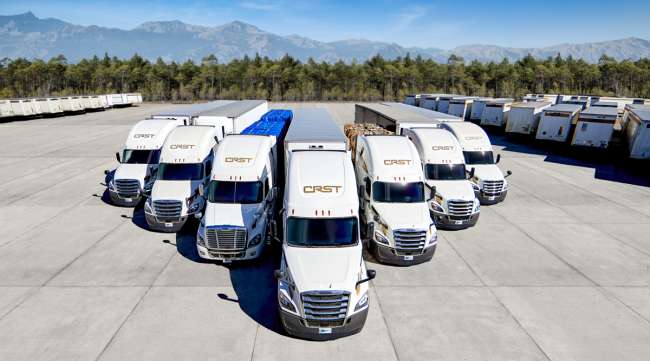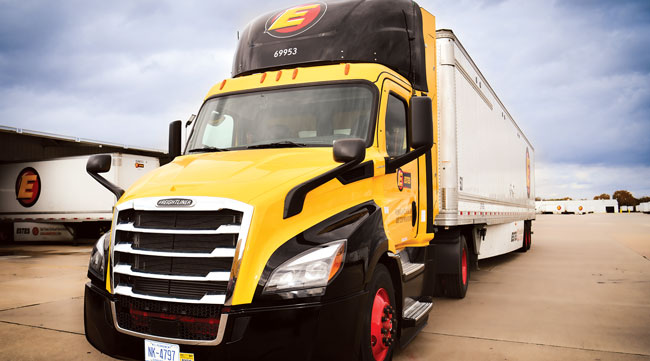Managing Editor, Features and Multimedia
Trucking Turns From Pandemic to Prosperity

[Ensure you have all the info you need in these unprecedented times. Subscribe now.]
After navigating the disruption and uncertainty wrought by the coronavirus pandemic last year, the trucking industry has entered a historically strong business environment that many analysts expect to endure for the rest of 2021 and beyond.
Optimism abounds for the overall U.S. economy as a growing percentage of the population receives COVID-19 vaccinations and pandemic-related safety restrictions continue to ease, paving the way for a boom in consumer spending.
Some observers have even drawn parallels to last century’s “Roaring ’20s,” a period of economic prosperity in the aftermath of the 1918 influenza outbreak and the end of World War I.
Freight demand, meanwhile, has been regaining momentum since mid-2020, with constrained truck capacity supporting rate increases for motor carriers.
Nonetheless, trucking companies continue to face some persistent headwinds. At the top of that list is the industry’s long-standing struggle to recruit enough professional truck drivers, a challenge that is perhaps more difficult now than ever before.
On the whole, though, industry experts believe the outlook for trucking is bright.

Costello
“We’re just in the beginning stages of this very robust recovery,” said Bob Costello, chief economist at American Trucking Associations.
“Some younger people have never seen an economy grow like this before,” he said. “People in their 20s and early 30s have never seen anything like this over a sustained period of time.”
Costello projected that full-year gross domestic product will expand by 6.4% in 2021, which would be the fastest annual growth rate since 1984. He also forecasts 4.3% full-year GDP growth in 2022, which still would be well above average.
As the country continues to turn the corner on the pandemic, consumer spending will power further increases in freight demand.
“People are ready to get out. They have been cooped up. They are ready to have fun. They’re ready to spend,” Costello said.
People are ready to get out. They have been cooped up. They are ready to have fun. They're ready to spend.
ATA Chief Economist Bob Costello
While a higher portion of that spending may be on less truck-intensive items, such as experiences rather than physical products, Costello said that there still is pent-up demand for goods.
At the same time, restocking also will bolster freight demand.
“Inventories at the retail level are just depleted,” Costello said. “They’re at the lowest level in history.”
Ironically, many consumers built up their savings during the past year because they weren’t spending money on live events and travel, for example, while also receiving economic stimulus checks from the federal government.
As a result, a lot of people feel a bit wealthier now than they did a year ago, said Noël Perry, principal at consulting firm Transport Futures and chief economist for the Transportation Intermediaries Association.
“What that says is there’s a lot of money looking for a home,” Perry said at TIA’s 2021 Capital Ideas Conference, held virtually May 11-13.
Amid this economic recovery, trucking is competing for labor with many other industries, including the construction and oil and gas sectors, said Donald Broughton, managing partner at Broughton Capital.
That dynamic will keep truck capacity tight, and therefore reinforce strong freight rates.
“Both the strength and the duration of pricing power for trucking is going to exceed expectations,” Broughton said.

Ekberg
Hugh Ekberg, CEO of diversified carrier CRST, also anticipates a very strong business environment for trucking through the balance of 2021 and probably into 2022, but said it’s “a bit unsettling” that demand is outstripping supply to such an extent.
“My honest opinion is it’s an incredibly imbalanced market,” he said. “It’s actually an unhealthy imbalance.”
With the driver shortage constraining truck capacity, motor carriers are commanding strong pricing right now in the over-the-road contract freight market, and they can afford to be more selective about which loads they accept.
The obvious concern, though, is that shippers will push back when the shoe is on the other foot, said Ekberg, who predicted that the freight market will turn sometime in 2022.
1. Driver shortage
For the fourth consecutive year, the shortage is the trucking industry’s top concern on the overall list. #ATAmce20 — American Trucking (@TRUCKINGdotORG) October 27, 2020
“I would rather have a more stable market where we’re getting customers to pay a premium for premium value and premium service,” he said, as opposed to paying a premium “just because they can’t get a truck from anybody else — but that’s our current reality today.”
Prior to entering the trucking business 4½ years ago, Ekberg worked for many years in the manufacturing, consumer goods and construction industries, where this level of pricing volatility didn’t exist, he said. Instead, vendors and customers formed closer working relationships to improve efficiency.
“You found ways to do things at a higher value at a lower cost by working together,” he said. “And I think this industry needs to get there.”
Trucking companies also will need to find ways to entice more workers to become professional truck drivers.
“I’m hopeful that we’ll start seeing people come back into the job market … and we get a closer balance between supply and demand, and that holds up in ’22 so that we don’t see rates come down too substantially and put the market into another freight recession like we saw in 2019,” Ekberg said.
CRST The Transportation Solution, based in Cedar Rapids, Iowa, ranks No. 24 on the Transport Topics Top 100 list of the largest for-hire carriers in North America.

Hirschbach CEO Brad Pinchuk says the current driver recruiting environment is the most difficult he's ever seen. (Hirschbach)
Trucking’s Worsening Labor Shortage
As the economy continues to gain steam, trucking companies are facing even more pressure to hire and retain drivers to meet the growing demand from shippers.
Hirschbach Motor Lines CEO Brad Pinchuk said the current driver recruiting environment is the most difficult he’s ever seen “by a long shot.”
“It’s always been tough, but on a scale of 1 to 10 right now … I’d put it at a 15 or something like that,” he said. “It’s really off the charts.”
To address that challenge, Hirschbach has hired about 50% more recruiters than it had a year ago and is spending more than twice as much on advertising, Pinchuk said. The refrigerated carrier also is trying new approaches, including establishing its own training program for commercial driver students.
Hirschbach received rate increases from its customers late last year and early this year, but Pinchuk said it hasn’t been enough to cover the rising costs of recruiting drivers and increasing their pay.
RELATED: Carriers Continue to Raise Wages Amid Driver Shortage
Shippers that are struggling to get their freight covered probably will need to budget for further rate increases, he said. “As much as we don’t want to go back and ask our customers for more money, it’s really something that we have to do in order to service their business.”
Hirschbach, headquartered in Dubuque, Iowa, ranks No. 66 on the for-hire TT100.
ATA’s Costello expects the tight capacity environment to continue.
The persistent driver shortage, driven by demographic factors such as an aging workforce and changing lifestyle preferences, has only gotten worse during the pandemic, he said.
The industry didn’t train enough new drivers last year due to pandemic-related closures or limited hours at training schools and department of motor vehicle locations.
At the same time, the Federal Motor Carrier Safety Administration’s drug and alcohol clearinghouse, which took effect in January 2020, has removed some drivers from the industry’s labor pool.
“You add it up, and we got into a hole in terms of capacity in 2020 that is going to take a while to dig out of,” Costello said.
He predicted that driver pay increases likely will continue as a result.
“The good news is we’ve got a good environment for growth, but fleets are going to have their hands full when it comes to getting and retaining enough drivers,” Costello said.
Although trucking companies are getting more creative in their efforts to attract new drivers, perhaps the most important thing they can do in this tough labor market is to keep their current drivers happy, CRST’s Ekberg said.
“All of us are going to be more focused on making sure that we do the right things for our drivers,” he said.
One benefit of today’s unbalanced freight market is that “drivers are getting the compensation they truly deserve,” Ekberg said. “It’s a very, very important job.”
The events of the past year have made that clearer than ever.
“The pandemic has highlighted how truly essential professional drivers are, and how important the transportation industry is to this economy — and everybody’s life,” Ekberg said.

Estes Express Lines experienced a surge in freight demand after navigating the early days of the pandemic. (Business Wire)
Weathering the Storm
The initial months of the COVID-19 pandemic were a harrowing time for many motor carriers.
Depending on the industry sectors they serve, some fleets experienced a spike in demand while others struggled financially as their customers temporarily closed or slowed production.
Broughton Capital reported that 3,140 trucking companies went out of business in 2020, nearly three times as many as the 1,100 carriers that closed down in 2019. Small carriers were hit the hardest, Broughton said.
Hirschbach, which primarily hauls food products across the country, experienced strong demand as consumers raided store shelves when the pandemic first took hold. After that initial surge, however, business slowed significantly in April and May of last year, particularly when several customers shut down their plants.

Hirschbach's Pinchuk says higher freight rates are necessary to support driver pay increases and cover recruiting costs. (Hirschbach Motor Lines)
During that trough, the fleet furloughed some drivers to keep its other drivers moving and worked closely with its shipper customers to secure as much freight as possible, Pinchuk said.
To help its more than 1,000 owner-operators make it through that challenging period, Hirshbach staff assisted them in navigating the application process for small business loans through the Paycheck Protection Program established by the CARES Act. Through that effort, Hirschbach’s owner-operators were able to secure loans for more than $5 million in total, Pinchuk said.
After making it through those difficult months, freight demand picked up again in the summer and kept building through the third quarter of last year.
“It was quite a challenge, but looking back on it, I’m quite proud of how our organization responded,” Pinchuk said.
After addressing supply chain disruptions and implementing safety protocols in the early days of the pandemic, less-than-truckload carrier Estes Express Lines quickly shifted its focus to managing higher freight demand.
“We literally went from worried about keeping all of our people working … and that was a very small time frame, to ‘Oh my goodness, we need to find more trailers, more tractors, hire more people, build more buildings,’ ” said Vincent Spataro, a district operations manager overseeing Estes’ southeastern U.S. operations.
Estes also experienced a surge in its e-commerce logistics business as consumers turned to online shopping, Spataro said during a panel discussion at the 2021 Georgia Logistics Summit, held virtually March 23.
“Being in that space, we saw massive, massive acceleration,” he said. “And it was daunting, and quite honestly hasn’t stopped.”
Estes Express, based in Richmond, Va., ranks No. 12 on the for-hire TT100.
CRST also cited final-mile delivery as a strong growth market moving forward. In March 2020, CRST acquired NAL Group, a final-mile logistics firm specializing in home delivery and installation of big and bulky products.
Technology Adoption Drives Efficiency Gains
The experience of adjusting to the pandemic ultimately may make trucking companies more efficient in the long run.
Apart from shifting office staff to remote work and communicating through videoconferencing, some companies used data analytics to improve utilization and adopted technologies such as contactless payment systems and electronic bills of lading to reduce friction and touch points.
See the 2021 Top 100 rankings
►Top 100 For-Hire Interactive Map
►Pandemic, Acquisitions Shake Up Top 100 List
►Fleets Turn Attention to Driver Lifestyle
►An Inside View of TT's Sector Rankings
Sector Rankings
LTL | TL/Dedicated
Intermodal/Drayage
Motor Vehicle/Driveaway
Tank/Bulk | Air/Expedited
Refrigerated | Flatbed/HS
Package/Courier | Mail
Household Goods/Commercial
Estes’ Spataro said technology-enabled improvements such as route optimization and streamlining payment processes can help make drivers more productive, which is more important than ever given the industry’s labor shortage.
“They need to be bumping docks,” Spataro said. “They don’t need to be waiting in line for payment at food warehouses.”
In addition to the driver recruiting challenge, trucking companies face several other headwinds.
Hirschbach’s Pinchuk pointed to nuclear verdicts and climbing insurance rates as rising concerns for motor carriers.
Infrastructure improvements are needed desperately, he said, adding that finding a safe place to park a commercial truck has become a real problem.
Despite those challenges, Pinchuk said well-performing trucking companies will be able to thrive today and into the future.
“Customers have an insatiable appetite for quality service. Those that can figure out how to provide it are going to have lots of opportunities presented to them,” he said. “I’m very bullish on what opportunities exist.”
Want more news? Listen to today's daily briefing below or go here for more info:





